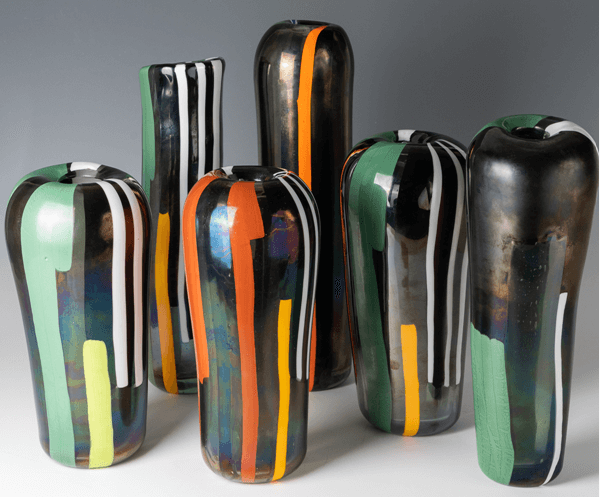Old Japan. Tea Ceremony "Aka Raku Yaki Chawan".
Experience the ancient art of tea-making with Old Japans Aka Raku Yaki Chawan - where tradition meets elegance.
Welcome to Old Japan, where we bring you the authentic Japanese tea ceremony experience with our exquisite Aka Raku Yaki Chawan. Handcrafted by skilled artisans using traditional techniques passed down for generations, this unique chawan (tea bowl) is a masterpiece of beauty and function. The deep red glaze and rustic texture evoke images of ancient Samurai warriors sipping tea before battle. As you hold the perfectly shaped bowl in your hands, it's as if time stands still, and you are transported to a simpler era where every detail mattered. The Aka Raku Yaki Chawan is not just a teacup; it’s an embodiment of art that will elevate your tea drinking ritual to the next level. Buy one today from Old Japan and immerse yourself in a world of serenity and refined taste!
- The Tea Ceremony, also known as Chanoyu, is an important part of Japanese culture and dates back to the 9th century
- Aka Raku Yaki Chawan is a type of tea bowl used in the Tea Ceremony that originated in Kyoto, Japan
- An original Japanese tea bowl, Natsu Aka Raku Yaki Chawan, Showa Era (1926-1989)
- An absolutely stunning Japanese Tea Bowl, Chawan, called Natsu Aka Raku Yaki (Natsu - summer; Aka - red; Raku - an old pottery family, Kyoto, Japan; Yaki - brand / product), with a signature / seal on the bottom (name unfortunately unknown for me)-
- The artist or artisan signed works are distinguished as artistic quality, exquisite individual pieces; unique and thus quite rare!
- For a long time in Japan is Raku-Ichi, Ni Hagi, San Karatsu what bedeudet first Raku, second Hagi, third Karatsu!
- Raku is a ceramic firing technique originally from Korea later Japan. It refers to both the name for the special clay, as well as the name for the entire production process and thereby incurred pottery. Raku means "joy" and is also the surname of a Japanese pottery dynasty. The technique spread since the 16th Century from Kyoto. In the second half of the 20th Century, the technology also spread to the west. According to legend, she was discovered by Zen monks, their shells manufactured for the tea ceremony itself, and they like one day wantonly threw into the fire to see what happens with them.
- A polychrome glaze on a light tone, a star ornament inside (see pictures), with a fantastic, white rabbit fur glaze, all on a red background - a CLASSIC, a classic summer dish (flat and wide), used, authentic and beautiful, with an absolutely fantastic Craquell inside (see pictures); raku glazes melt between 800 ° C and 1000 ° C (low fire). The glaze surface tears during cooling to obtain the typical Craquell arises. Coloring oxides mostly iron oxide and copper oxide are due to the strong color change. Also metal salts are used, with the original packaging, for a Chado connoisseurs a well very impressive and very rare piece; absolutely wabi-sabi!
- An original Japanese tea bowl, Natsu Aka Raku Yaki Chawan, Showa Era (1926-1989)
- An absolutely stunning Japanese Tea Bowl, Chawan, called Natsu Aka Raku Yaki (Natsu - summer; Aka - red; Raku - an old pottery family, Kyoto, Japan; Yaki - brand / product), with a signature / seal on the bottom (name unfortunately unknown for me)-
- The artist or artisan signed works are distinguished as artistic quality, exquisite individual pieces; unique and thus quite rare!
- For a long time in Japan is Raku-Ichi, Ni Hagi, San Karatsu what bedeudet first Raku, second Hagi, third Karatsu!
- Raku is a ceramic firing technique originally from Korea later Japan. It refers to both the name for the special clay, as well as the name for the entire production process and thereby incurred pottery. Raku means "joy" and is also the surname of a Japanese pottery dynasty. The technique spread since the 16th Century from Kyoto. In the second half of the 20th Century, the technology also spread to the west. According to legend, she was discovered by Zen monks, their shells manufactured for the tea ceremony itself, and they like one day wantonly threw into the fire to see what happens with them.
- A polychrome glaze on a light tone, a star ornament inside (see pictures), with a fantastic, white rabbit fur glaze, all on a red background - a CLASSIC, a classic summer dish (flat and wide), used, authentic and beautiful, with an absolutely fantastic Craquell inside (see pictures); raku glazes melt between 800 ° C and 1000 ° C (low fire). The glaze surface tears during cooling to obtain the typical Craquell arises. Coloring oxides mostly iron oxide and copper oxide are due to the strong color change. Also metal salts are used, with the original packaging, for a Chado connoisseurs a well very impressive and very rare piece; absolutely wabi-sabi!
- Free Shipping over 400€ except furniture & heavy Objects.
Free Shipping Worldwide over 400€ except furniture, heavy Objects and Lamps.
The Rates are valid for glass, lamps and exclusive gifts not for furniture and big lamps. Please ask for shipping quotes in this case.
Worldwide Shipping incl. insurance: 0-5 kg: 70.00.€ 5-10 kg: 100.00€. 10-20 kg: 1500.00€. 20-30 kg: Sfr. 120.00€.
Switzerland: Standard Shipping incl. insurance: 0-5 kg: 14.00€. 5-10 kg: 18.00€. 10-25 kg: Sfr. 28.00.
HEAVY ITEMS:
Switzerland 25-60kg: 180€
Europe 10-80kg: 480€
In case you want to ship to other countries please ask for shipping quotes.
Should you wish to return any Object we will refund it within 30 days of the receipt.


















